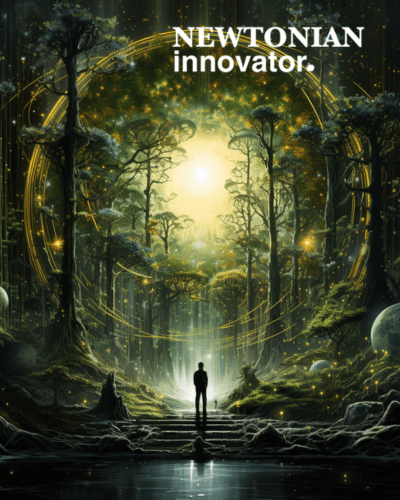The Gaia hypothesis is an influential concept proposed by scientist James Lovelock in the 1970s. It suggests that the Earth and all the life on it functions as a single, self-regulating system that maintains conditions suitable for life. Lovelock arrived at this idea while working for NASA to detect life on Mars. In thinking about how to identify life on another planet, Lovelock realized that the Earth’s atmosphere and oceans have remarkably stable chemical compositions compared to those on other planets. This stability allows life to thrive.
James Lovelock was born on July 26th, 1919 in Letchworth, England. His parents were working class as his father was a craftsman and his mother a writer. As a child, Lovelock had a deep curiosity about science and fondness for inventing things. He attended public school where his teachers recognized his potential in science at an early age. Lovelock went on to study chemistry, biochemistry and medicine at the University of Manchester and London School of Hygiene and Tropical Medicine.
After university, Lovelock began working for the Medical Research Council and later took a position at NASA, where he would conceive the revolutionary Gaia hypothesis. In his personal life, Lovelock married Helen Hutt in 1942. They had four children together and were married for over 65 years until her death in 2009. Lovelock lived an active life well into his 90s, continuing his work on the Gaia theory while speaking out about environmental issues. He has received numerous awards for his scientific contributions, including being named a Fellow of the Royal Society in 1974. Now over 100 years old, Lovelock remains one of the most influential independent scientists of the 20th century, known best for his Gaia hypothesis that transformed views of Earth’s systems.

The Gaia hypothesis was a radical scientific concept that brought James Lovelock significant fame and influence. Though controversial at first, it shaped the course of his career from the 1970s onward. While working for NASA with a focus on Mars, Lovelock realized that Earth’s atmosphere is remarkably different compared to other planets as it has stable chemical compositions perfect for sustaining life. This observation led him to theorize that life creates these habitable conditions through a planetary self-regulating system.
Lovelock named this idea after the Greek goddess Gaia, representing Earth as one living organism. The Gaia hypothesis stimulated new research in many fields, like atmospheric science, geology, and biology. It caused scientists to think differently about the interconnectedness of life on Earth. Though it took time for mainstream science to accept, the theory brought Lovelock recognition. He published popular books on Gaia that brought his ideas to the general public. Lovelock received awards honoring him as one of the most creative independent scientists of his time.
The provocative thought experiment he conceived out of questioning how to detect life on Mars set the course for his distinguished career. At the time, scientists assumed that Mars’ atmosphere would be similar to Earth’s, composed largely of nitrogen and oxygen. However, data from NASA probes showed the Martian atmosphere was instead almost entirely carbon dioxide. Lovelock found it striking that Earth stood out from other planets in having an atmosphere so perfectly suited to sustaining life.
This observation led Lovelock to think deeply about how Earth’s atmosphere could remain in a state of chemical equilibrium that was ideal for life. He started questioning the accepted idea that life simply adapted to the given conditions of the planets it inhabited. Could it be that life plays an active role in shaping its environment? Lovelock began exploring the idea that the Earth’s biosphere, atmosphere, oceans, and soils are closely integrated to form a complex interacting system that maintains the conditions for life. In other terms, Lovelock’s idea challenged the traditional notion that life simply adjusts to the environment it is in. Instead, he suggested the opposite, that life actively participates in molding and shaping its environment to create conditions that are conducive to its survival and to flourish.
The key principle was that organisms coexist with their inorganic surroundings, unconsciously regulating physical and chemical conditions on the planet through feedback loops and other mechanisms. For instance, photosynthetic bacteria produce oxygen needed for other lifeforms. Life overall modulates global temperature, ocean salinity, and atmospheric gases to keep the environment habitable.
Lovelock emphasized that Gaia was not a conscious entity, but rather emergent self-regulation arising from diverse organisms pursuing survival in their own niche. However, Gaia implies a degree of coincidence, with the Earth acting like a vast, living superorganism. This challenges the view that life simply adapts to whatever conditions it encounters on a planet. The Gaia hypothesis presents life and environment evolving in tandem through feedback mechanisms that enable long-term habitability. Gaia thinking emphasizes the interconnectedness of all living things and reminds us that we have a collective responsibility for maintaining a habitable planet.
James Lovelock’s radical Gaia hypothesis demonstrates the immense value of questioning accepted theories and thinking creatively about Earth’s complexity. The Gaia concept was sparked by Lovelock’s willingness to challenge the assumption that life simply adapts to planetary conditions. This thought process and open-mindedness allowed him to conceive of a different model where life actively regulates the environment. Lovelock’s interdisciplinary knowledge, from chemistry to medicine, enabled him to perceive Earth as an integrated system in a way few others had before.

The interdisciplinary nature of Gaia thinking should inspire future scientists to explore concepts that bridge gaps between specialties. We need more scientists like Lovelock who are not afraid to think boldly and synthesize knowledge across domains. This highlights the utility of conceptual exercises for revealing new possibilities. Future scientists should be inspired to actively pose theoretical questions and pursue hypothetical scenarios to push the boundaries of knowledge. Like Lovelock’s work on Gaia, the right thought experiment at the right time can yield transformative scientific paradigms.
Drawing inspiration from Lovelock’s Gaia hypothesis, one can’t help but ponder the vastness of our universe. Lovelock’s findings into Earth’s self-regulating nature can be pivotal in our battle against climate change and environmental degradation. However, beyond the immediate applications, the Gaia hypothesis also prompts us to dream bigger. If Earth, our home, is a living, breathing entity, what does that imply about the swirling galaxies or the vast cosmic networks that stitch the universe together?
Lovelock’s Gaia hypothesis challenges us to view our world, and perhaps even our universe, through a different lens. He saw Earth as a harmonious, interconnected system. In the same nature, might we one day discover that galaxies or even the entire universe follow a similar pattern, with stars, planets, black holes, and dark matter all playing their part in a grand cosmic system? As we are currently exploring other planets and potentially discovering extraterrestrial life, Lovelock’s vision reminds us of the infinite possibilities that await when we dare to think differently.
As we gaze up at the night sky, let us remember the lessons from Lovelock, that the universe is full of mysteries waiting to be unraveled, and that the key to unlocking these secrets often lies in challenging our preconceived notions and daring to envision the unimaginable. The stars above might not just be balls of gas and fire, but could be part of a grander, interconnected system, much like our Earth. As we venture deeper into this vast universe, let us carry with us the spirit of curiosity, with wonderment and a boundless imagination.




